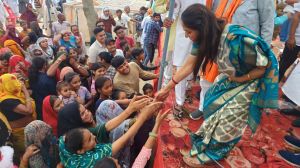- India
- International
Explained: A short recent history of Daman & Diu, Dadra & Nagar Haveli
Here's how the two Union Territories that are now proposed to be merged into one came under Portuguese rule and were snatched back by independent India.
 Artists performing on the theme of ‘Dadra and Nagar Haveli’ (File/Express Photo by Kamleshwar Singh)
Artists performing on the theme of ‘Dadra and Nagar Haveli’ (File/Express Photo by Kamleshwar Singh)
On Tuesday (November 26), a Bill was introduced in Lok Sabha to merge two Union Territories, Daman and Diu and Dadra and Nagar Haveli, into one. Both the UTs are located on India’s western coast near Gujarat, and were colonial possessions of Portugal before they became part of independent India.
How did Daman and Diu and Dadra and Nagar Haveli come under Portuguese rule, and how did they join independent India?
Daman and Diu
Before the arrival of the Portuguese, both Daman and Diu (which are separated by the Gulf of Khambhat) were part of the Sultanate of Gujarat — an independent kingdom comprising present-day Gujarat and neighbouring areas during the 15th and 16th centuries.
Early in the 16th century, the Sultan of Gujarat, Bahadur Shah, came under immense pressure when his kingdom was invaded by the second Mughal Emperor Humayun.
At that juncture, he decided to remain on conciliatory terms with the Portuguese, who had arrived in India at the end of the 15th century, and were at the time an energetic and ambitious maritime power.

In 1534, the Shah signed the Treaty of Bassein with the Portuguese, ceding Diu to the latter, as well as other territories of his empire such as Vasai and the islands that today form Mumbai. The Portuguese obtained Daman from the Shah in 1559.
Diu became an important port for the Portuguese, who built a large fortress there, as well as other buildings. Within a few years of acquiring the island, Gujarati ships using the port of Diu were required to pay duties to the Portuguese.
For over four centuries, both Daman and Diu remained part of the Portuguese dominions in India, and were ruled from Goa.
Dadra and Nagar Haveli
Nagar Haveli passed from its Rajput rulers to the Marathas in the mid-18th century. It was transferred to the Portuguese in 1783 as compensation for a ship that the Marathas had destroyed. The Portuguese then acquired Dadra in 1785.
Operation Vijay
After India’s independence from Britain, Lisbon refused to hand over its territories in India, and claimed that they were an integral part of Portugal. On a diplomatic level, India tried to persuade Portugal to transfer its territories peacefully.
Locally, Indian nationalists organised resistance against Portuguese occupation. In 1954, they were able to seize Dadra and Nagar Haveli, and an economic blockade was imposed over the rest of the Portuguese-held territories. The loss of Dadra and Nagar Haveli sent alarm bells ringing for the Portuguese, and security was beefed up in their remaining Indian possessions.
According to the 2018 book ‘Independent India’s All the Seven Wars’ by Col Y Udaya Chandar (retd.), additional troops were brought in from Portugal, Angola, and Mozambique (the latter two were Portuguese colonies until 1975), and around 8,000 European, African, and Indian troops were split between the districts of Goa, Daman and Diu.
In December 1961, as attempts at conciliation failed, India launched Operation Vijay against Portuguese India. While most of the hostilities took place in Goa, the Daman and Diu territories also witnessed action.
At Daman, the Portuguese had a garrison and an air tower, and they had secured the region with small minefields. The ground advance on Daman was carried out by the 1 Maratha Light Infantry on December 18, which suffered four casualties.
The air attack was carried out by Mystere fighters of the IAF, which attacked Portuguese mortar positions inside the Moti Daman Fort.
Ten Portuguese soldiers were killed, and around 600 were taken prisoner after their side surrendered. A Portuguese naval ship, fearing capture, sailed to Karachi in Pakistan.
At Diu, the ground offensive was undertaken by the 20 Rajput and 4 Madras, also on December 18. The INS Delhi bombarded targets on the shore. The IAF inflicted heavy damage, ultimately forcing the Portuguese to surrender.
After the Portuguese left
Immediately in December 1961, Goa, Daman and Diu were constituted into the Union Territory of Goa, Daman and Diu.
In 1967, a referendum called the ‘Goa Opinion Poll’ was held, where voters were asked to decide whether the UT should be merged with Maharashtra or should remain separate.
The mandate was against a merger, and the UT continued as before. In 1987, Goa achieved statehood, and Daman and Diu became a separate UT.
Between 1954 to 1961, Dadra and Nagar Haveli was administered by a citizen’s council called the Varishta Panchayat of Free Dadra and Nagar Haveli. In 1961, it became a Union Territory.
Don’t miss from Explained: Who is Jabir Moti, the alleged Dawood man that the US wants extradited?
More Explained
EXPRESS OPINION
Apr 25: Latest News
- 01
- 02
- 03
- 04
- 05









































